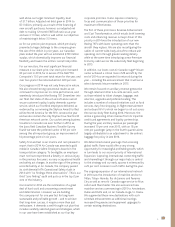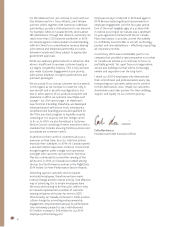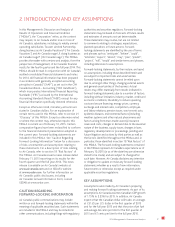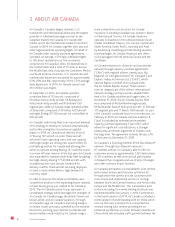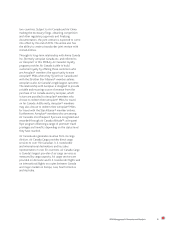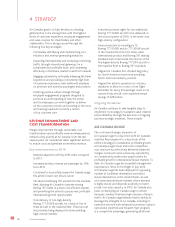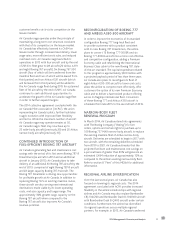Air Canada 2014 Annual Report Download - page 15
Download and view the complete annual report
Please find page 15 of the 2014 Air Canada annual report below. You can navigate through the pages in the report by either clicking on the pages listed below, or by using the keyword search tool below to find specific information within the annual report.
15
2014 Management’s Discussion and Analysis
STAR ALLIANCE MEMBERSHIP,
CODESHARE AND JOINT VENTURE
AGREEMENTS ENHANCE MARKET
PRESENCE
The development of commercial alliances with
major international carriers continues to be an
important aspect of Air Canada’s business strategy.
These arrangements provide Air Canada with an
effective way to leverage expansion and broaden its
network appeal. Air Canada extends its global reach
through its membership in Star Alliance® which is
comprised of 27 members. The airline also enhances
its network through its participation in a transatlantic
revenue sharing joint venture with United Airlines
and Deutsche Lufthansa AG, referred to as A++. By
coordinating pricing, scheduling and sales, Air Canada
is better able to serve customers by offering
more travel options, while reducing travel times.
Air Canada is also achieving greater critical mass and
network scope through numerous codeshare and
interline agreements. Air Canada codeshares with all
Star Alliance members, with the exception of Adria
Airways, Copa Airlines, Croatia Airlines, EVA Air,
Shenzhen Airlines and Thai Airways. In October 2014,
Air Canada and Air India introduced a series of new
codeshare routes to improve air travel connectivity
between Canada and India.
In November 2014, Air Canada concluded a
memorandum of understanding with Air China which
sets out the main principles for a comprehensive
revenue sharing joint venture between the parties.
The agreement provides for an enhanced partnership
on routes between Canada and China which will
stimulate traffic growth between the two countries.
The joint venture will generate additional service and
pricing benefits for consumers travelling between
the two countries as well as provide for enhanced
cooperation between the two carriers in the areas of
sales, marketing and airport operations. Subject to
Air Canada and Air China making the necessary filings,
obtaining competition and other regulatory approvals
and finalizing documentation, the joint venture is
expected to come into effect by the
end of 2015.
INCREASING INTERNATIONAL-TO-
INTERNATIONAL TRAFFIC FLOWS
THROUGH MAJOR CANADIAN HUBS
Air Canada has made targeted and meaningful
progress in increasing international-to-international
traffic flows (also known as sixth freedom traffic)
through its major Canadian hubs.
In 2015, Air Canada plans to continue to grow this
traffic through its world-class hub in Toronto and its
strong international gateways in Montreal, Vancouver
and Calgary. The airline believes that it has the
potential to grow sixth freedom traffic, particularly
from the U.S., over the coming years given its award-
winning products and services, geographically well-
positioned hubs in Canada, extensive network and
other competitive advantages.
In 2014, Air Canada increased sixth freedom traffic
connecting at Air Canada major Canadian hubs by 23%
from 2013. Based on an airline industry benchmark
indicating the percentage of traffic from the U.S. to
Europe and Asia by non-U.S. carriers, Air Canada’s
current share is 0.8% (this market share is consistent
with Air Canada’s previously reported 0.3% share
but is now adjusted to include certain GDS and fuel
surcharge revenue). Air Canada has determined that
its fair share of this international-to-international
transit traffic should be 1.5% and has estimated that
a successful increase to this level (taking into account
the above-referenced GDS and 2014 industry fuel
surcharge levels) would drive incremental annual
revenues of approximately $600 million.
For several years, Air Canada has worked closely with
the Greater Toronto Airports Authority (“GTAA”)
to transform Toronto Pearson into a leading North
American airport and gain a greater share of the
global sixth freedom market. In late 2013, the GTAA
and Air Canada concluded an enhanced commercial
relationship which is designed to deliver continued
improvements to customer service and which has
placed Air Canada in a better position to more
profitably target a larger share of international traffic
flows. Toronto Pearson has a strategic advantage
due to its proximity to densely populated major
markets in the U.S. and is also a destination for
a large number of business and leisure travellers.
Moreover, Air Canada and its Star Alliance® partners’
operations are consolidated in one terminal, and
Toronto Pearson has efficient in-transit facilities which
allow passengers and their bags to move seamlessly
between Canada and U.S. Customs and Immigration.


